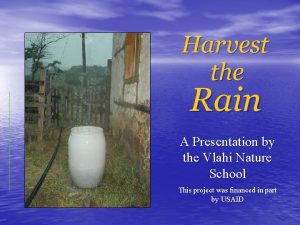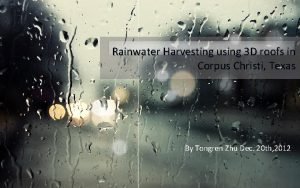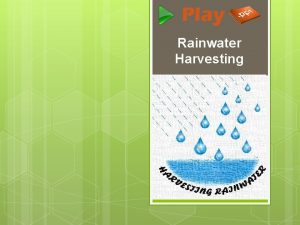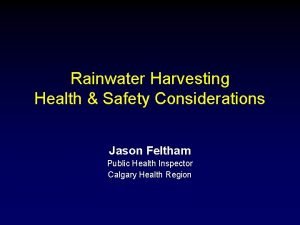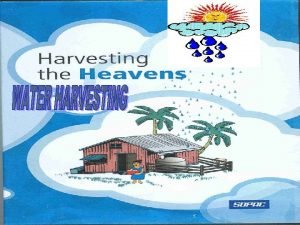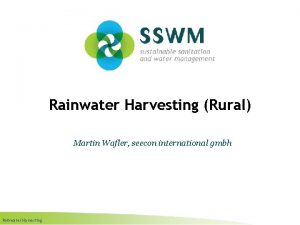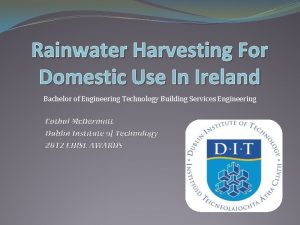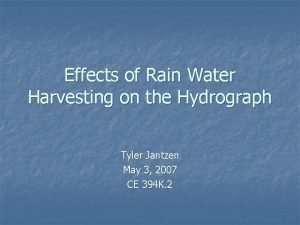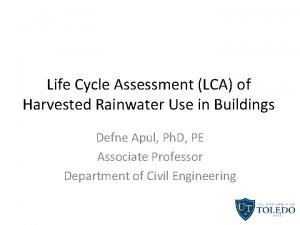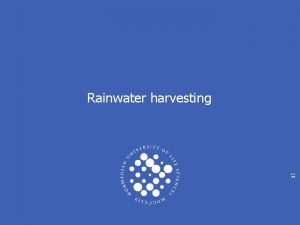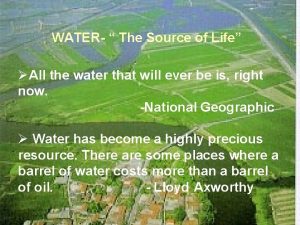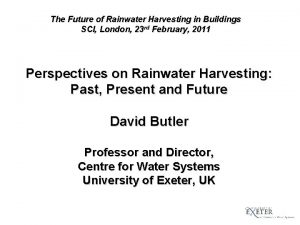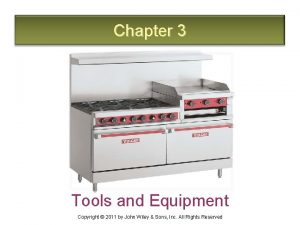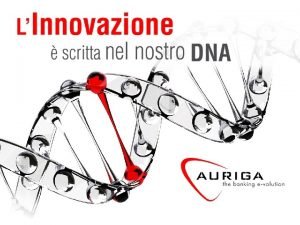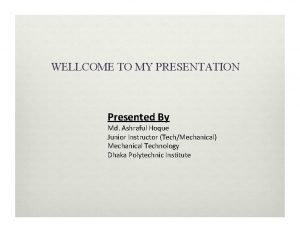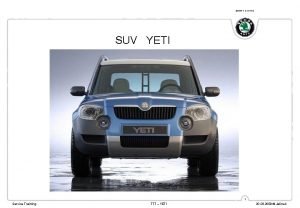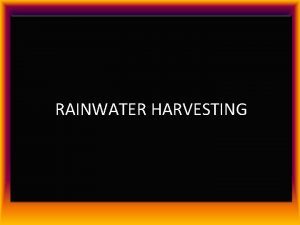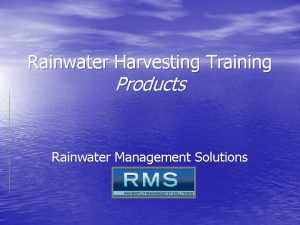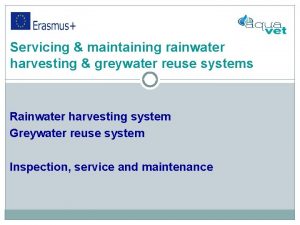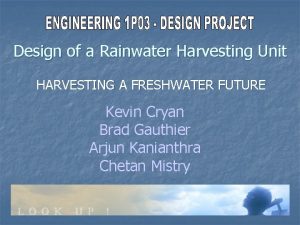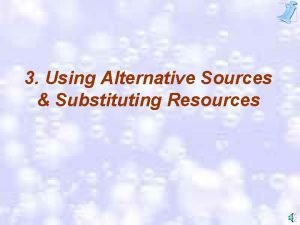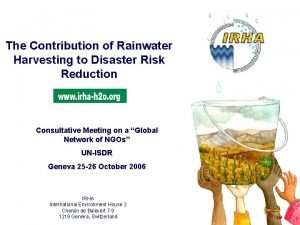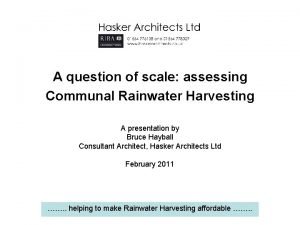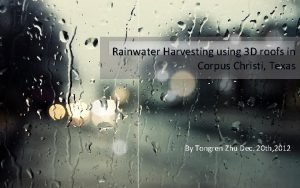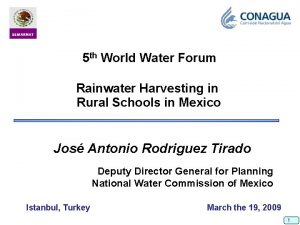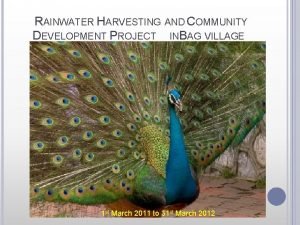RAINWATER HARVESTING The harvesting of rainwater simply involves

















- Slides: 17

RAINWATER HARVESTING

� The harvesting of rainwater simply involves the collection of water from surfaces on which rain falls, and storing this water for later use. Normally water is collected from the roofs of buildings and stored in rainwater tanks. Water can also be collected in dams from rain falling on the ground and these assist the draining away of water.

What is rainwater harvesting � � Rainwater harvesting means capturing rain where it falls or capturing the run off in your own village or town. It involves taking measures to keep that water clean by not allowing polluting activities to take place in the catchment area. Rainwater from rooftops should be carried through downtake water pipes or drains to a storage/harvesting system. Water from sloping roofs could be caught through gutters and downtake pipes. At terraces, the mouth of each drain should have wire mesh to restrict floating material.


� Over the last number of years, Cloudbrook water company has successfully expanded into all activities of the rainwater recovery and water treatment sectors in Ireland beyond. The utilisation of cutting edge technology easily integrated with traditional skills, lead by a highly motivated and dynamic management team has brought the company to the forefront of rainwater recovery, treatment, manufacturing and installation in the residential, commercial, educational and industrial sectors.

� Cloudbrook Water management team and work force command the resources and expertise to undertake projects of all types and sizes in both public and private sectors.

� Cloudbrook Water Company - Rainwater to Drinking Water Systems, provide water which is independently treated to remove and destroy microbiological contaminants, viruses, cysts, chlorine and other impurities that can be found in water that is not properly treated.

� They design, develop and bring to market innovative water treatment technologies that distribute clean drinking water from rainwater in a pure, fresh, safe, natural, sustainable and economically advantageous way.

� You can have a developed system which treats rainwater to drinking water standard for all your household and business needs. This is achieved by using new rainstation and rainwater filtration technology.

The benefits of converting rain water to drinking water are: • Provides treated water for all your needs • Delivers safe drinking water • Removes bacteria and chlorine from your water to make your water healthier and better tasting • Gives you complete control over your private water supply • Adds no chemicals to your water • Can save you money on water bills

� � We designed a Water Usage survey and we gave one to Robert O’Brien, a worker at Cloudbrook. The results of our survey are on the following slides.

The Company Survey � � � 1. Does a person have specific responsibility for monitoring the use of water in your business? Yes 2. Do you know the location of the water meter? Yes 3. Do you read the water meter regularly? Yes

The Company Survey � � � 4. Do you check whether water is being used in your buildings when they are empty? Yes. 5. Do you regularly look for leaks from over flows, pipes, joints, connections and fittings? Yes 6. Do you have a procedure for reporting and repairing leaks? Yes

The Company Survey � � � � 7. Are there any water saving devices associated with the taps? Rainwater system feeds taps, toilets, etc 8. Do you have a low volume toilet cistern (6 litres)? Yes 9. Do you have a canteen/kitchenette? Yes 10. Is water used sparingly when cleaning? Yes

The Company Survey � � � � 11. Are air conditioning and heating units turned off when the building is empty? N/A 12. Are hot and cold water pipes and tanks adequately insulated against frost? Yes 13. Do you consider water efficiency when purchasing new appliances/fittings? Yes 14. Do staff receive training on the importance of saving water? Yes

The Company Survey � � � 15. Where do you use water? Canteen, sinks , toilets, when washing the van. 16. Have you implemented any changes in your water usage recently? We are a rainwater recovery company so most of our water usage is from rainwater. 17. Do you think there are other ways you could conserve water? Add more rainwater storage tanks to our system.

� �The End By � Eadaoin Moroney , Aoife Frost , Lilly Kavanagh and Myra Donnellan
 Conclusion of rainwater harvesting
Conclusion of rainwater harvesting Reference of rainwater harvesting
Reference of rainwater harvesting Rainwater harvesting introduction
Rainwater harvesting introduction Rainwater harvesting calgary
Rainwater harvesting calgary Conclusion of rain water harvesting
Conclusion of rain water harvesting Function of rainwater harvesting
Function of rainwater harvesting Rainwater harvesting systems cork
Rainwater harvesting systems cork Domestic rainwater harvesting systems
Domestic rainwater harvesting systems What is rainwater harvesting
What is rainwater harvesting Life cycle assessment of rainwater harvesting
Life cycle assessment of rainwater harvesting Bibliography for rainwater harvesting
Bibliography for rainwater harvesting Coarse mesh in rainwater harvesting
Coarse mesh in rainwater harvesting Future of rainwater harvesting
Future of rainwater harvesting This operates simply by heating air in an enclosed space.
This operates simply by heating air in an enclosed space. Simply rivas
Simply rivas Simply mobile
Simply mobile Shear force and bending moment
Shear force and bending moment Clever
Clever
